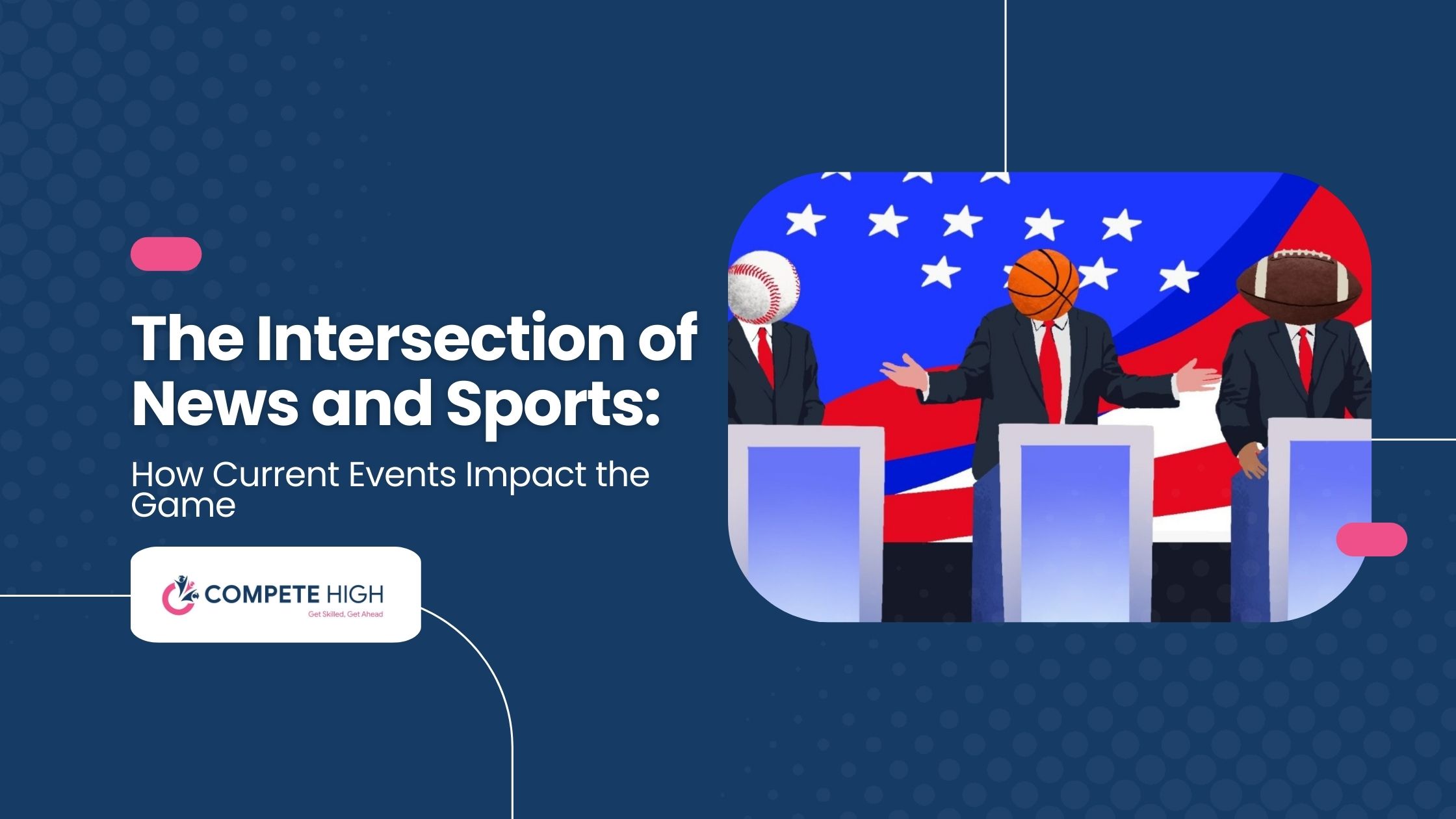
News and sports are closely interconnected, and current events have a profound influence on the world of sports. It is important to know how political, social, economic, and cultural events influence the sporting world. This guide examines the different ways in which news and sports, and current affairs can shape and affect sports worldwide.
Political Events, News and Sports
International Relations
International relations are another important determinant in global sports. Countries that have diplomatic relations or conflicts with each other can influence international sporting events. For instance, the Olympic Games, the world's premier international sports event, have not been immune to geopolitics. In January, the United States led a massive boycott of the Moscow Olympics to protest the Soviet invasion of Afghanistan. The Soviet Union and its allies reciprocated with a boycott of the 1984 Los Angeles Olympics. These political gymnastics affected not only the participating athletes but also the spirit and competitive integrity of the games.
Furthermore, sporting occasions are often showcased for political protest. Athletes have used the global reach of events such as the Olympics to speak out about political issues in a way that gets the attention of the world and to bring important issues such as racism and human rights abuses to the fore. Tommie Smith and John Carlos's Black Power salute at the 1968 Mexico City Olympics is a classic example of this.
Government Policies
Policies at the domestic level have a big effect on sports, too; while some of these policies encourage the development of sports on a national scale, others actually hamper its development. Countries that invest a huge amount of resources into developing sports complexes, training facilities, and supporting systems for athletes must have amazing performances in international competitions. China, for instance, has grown into an Olympic powerhouse through the implementation of a series of state-sponsored sports programs that are extremely demanding.
Political decisions on the construction of new sports facilities and stadiums can also reshape local communities and economies. Political decisions on resources that go into sports development reflect wider political priorities and agendas. Immigration and international travel policies affect the composition of sports teams, especially in professional leagues where international talent is an important factor.
Social Issues and Sports
Social Movements
Sports have a long history of being used as a vehicle for social change, so athletes have played an important role in helping to move social issues forward. Athletes have been supporters of social movements, including Black Lives Matter, whose message has been able to reach a broad audience thanks in part to athletes who have used their platforms to draw attention to racial injustice and inequality.
From footballer Colin Kaepernick's protests against racial injustice by kneeling during the national anthem to the US women's soccer team's fight for equal pay, which has sparked headlines and debate worldwide, it seems that athletes have been leading important conversations about race, equality, and gender in sports and beyond. Female athletes, in particular, have led the charge. They have stood up for gender equality, speaking out against pay gaps and the sexist portrayal of female athletes.
Public Health Crises
Public health crises, whether they're pandemics or other types of scourges, disrupt the sporting calendar and athlete health and safety. The COVID-19 pandemic brought the sports industry all over the world to a standstill. The Tokyo 2020 Olympics were postponed for the first time in their 124-year modern history, while leagues and tournaments were disrupted in unprecedented ways. The health and safety of athletes became a crucial factor, prompting the imposition of stringent health protocols and biosecure bubbles.
The pandemic has also seen sports administrations adapt to new realities and respond to changing consumer behaviors, for example, in how sports events can be held without spectators or on digital platforms and how fan engagement can take place. The financial impact was considerable: many sports administrations suffered substantial losses in revenue from ticket sales and sponsorship when live sports ceased; mental health services have raised the agenda for athletes coping with the stress and anxiety of a disrupted competitive schedule.
Economic Factors in Sports
Economic Downturns
When the economy is bad, it affects every aspect of sports, from teams' finances to event staging. When the economy is in a recession, companies have less money to spend on marketing and sponsorships, which causes sports organizations to have less money. This results in fewer teams and fewer events being sponsored, or lower money for the teams or events. Organizations will then have to cut costs, such as by firing staff, reducing marketing efforts, or canceling events.
For example, the global financial crisis of 2008 impacted sports organizations worldwide. In countries around the world, teams saw a decline in revenue from ticket sales and merchandising as fans cut back on discretionary spending. Corporate sponsors are also feeling the squeeze, either withdrawing or scaling back sponsorships, putting more financial pressure on sports teams and events.
Economic downturns can also reduce fan attendance as families and individuals cut back on spending, and sports tickets and related merchandise aren't a high priority. This can directly affect the revenue of sports organizations that are primarily supported by gate receipts and in-stadium sales.
Market Trends
Of course, the economic developments and market forces that shape the sports industry are widespread and, in some cases, familiar. The rise of esports reflects broader market shifts towards digital entertainment and interactive experiences. Traditional sports face falling audiences, especially among younger viewers. Meanwhile, esports are booming, attracting big investment and sponsorship deals. The rise of esports and other new forms of competition and fan engagement reflects the need for adaptability within the sports industry.
How fans watch sports is another critical market trend. With the rise of streaming services and the increasing demand for on-demand content, sports broadcasting is changing. Consumers have new ways to watch sports—and new ways to watch on demand—altering the economics of sports media rights and the way that sporting organizations monetize their broadcasts. The changing legal and technological frameworks around sports betting are creating another important economic trend: new revenue streams for sports as well as new ways for fans to engage.
Technological Advancements
Media and Broadcasting
The latest and greatest technologies have dramatically changed sports media and broadcasting, revolutionizing how fans consume sports and access their favorite teams and athletes. Live-streaming is the new way to watch games and events, with fans watching sports in real-time on the internet or digital devices. This access has made sports more global, as people from all over the world can watch sports and get involved.
Social media has also played a crucial role in sports broadcasting, as athletes, teams, and leagues have established a presence on Twitter, Instagram, and TikTok to engage fans and share behind-the-scenes content and real-time updates. Indeed, this direct connection has not only led to a boon in fan loyalty but also allowed new revenue streams through sponsored content and advertisements.
They introduce new dimensions to fan experiences: VR can offer full immersion, making fans feel as if they are in action (even when they are just in their living rooms). AR can also enhance live events, providing real-time statistics, interactive features, and analysis of the viewing experience for enhanced insights and engagement.
Sports Science and Performance
Through technological advancements in sports science, athletes are able to perform better and also prevent injuries. Wearable technology, such as fitness trackers and smart clothing, helps athletes and coaches track performance metrics in real time. Examples of these metrics are the heart rate, movement patterns, and exertion levels. This enables them to develop better training programs, monitor progress, and avoid overtraining.
Performance analytics are fundamental to modern sports. Today, teams use advanced data to make decisions with the goal of maximizing their probability of winning. Analytics can reveal patterns in play and identify areas of strength and weakness. Be it basketball, football, or baseball, teams can better refine their playbooks based on analytics about shooting patterns, defensive efficiencies, and other key factors. They can also use analytics to enhance the process of scouting and talent development.
Athletes and their trainers have also exploited innovation to prevent injuries and hasten recovery. Motion-capture systems and biomechanical analysis software help athletes avoid injury by identifying risk factors and tailoring training regimens to avoid those risks. Innovation in medical technology—for example, advanced imaging techniques and regenerative medicine—has also contributed to faster, safer diagnosis and treatment of athletes' injuries, helping them return to play sooner.
Cultural Shifts
Changing Fan Preferences
The fashion of the day often has a direct effect on public interest in team sports and the engagement of fans with them, sometimes completely altering the perception of a sport and causing heightened interest in it. One way that public interest in sports is changing is the growing popularity of women's sports. There has been an escalating interest in women's sports teams and leagues, an increase in sponsorship, and more media attention in recent years. This shift is due to society's move toward equality and women's empowerment. For example, the FIFA Women's World Cup is attracting record-breaking numbers of viewers.
Furthermore, the decision to introduce new sports into major competitions, such as the Olympics, also reflects changing consumer tastes. We see this in the introduction of sports such as skateboarding, surfing, and climbing—disciplines that are more appealing to younger audiences—to the Olympic program, broadening its appeal and making it more relevant to a wider audience of spectators and participants. This reflects a growing inclination to incorporate a wider variety of sports disciplines and cater to an expanded repertoire of interests and cultural trends.
Globalization of Sports
The globalization of sports is leading to the increasing diffusion and internationalization of different kinds of sports around the world. As a result, the phenomenon is also manifesting in the commercialization of sports on a global scale. A clear illustration of the internationalization of sports is that international leagues like the English Premier League and the National Basketball Association, among others, have become a global phenomenon, attracting fan bases from around the world. These leagues, for instance, are now considered among the most watched and most commercialized leagues on the planet. Such global reach for sports is attributed to the use of the media, international broadcasting rights, and the presence of international players in the leagues.
Globalization has also had the effect of drawing in cultural influences from other sports. For example, the growth of the NBA in China has not only increased the NBA's fan base but has also helped to develop basketball in China, leading to a rise in local leagues and talent. Similarly, European football clubs have created training academies and partnerships in Africa, Asia, and the Americas, which have helped to grow football worldwide.
Legal and Ethical Issues
Doping and Fair Play
The legal and ethical issues surrounding doping controversies are mammoth in scale and have an enormous impact on the activity of sports. The scandals in recent times surrounding the doping cases involving Lance Armstrong, Maria Sharapova, and, most recently, a state-sponsored doping program in Russia have further rekindled the issue of doping in sports. The WADA (World Anti-Doping Agency) lays down the standards, conducts tests, and imposes punishments to ensure that news and sports remain clean.
Various campaigns to combat it consist of tests, educational programs, and severe penalties against offenders. Without all of these measures, sport would lose its credibility, and athletes might come to harm and have their careers ruined by the use of drugs. Nevertheless, the very nature of performance-enhancing drugs and doping methods means that the war on doping will never be over.
Athlete Rights and Welfare
The courts are also hearing more high-profile legal claims about athlete contracts, rights, and welfare. These include pay equity cases, mental health issues, and questions about athlete advocacy. Female athletes have taken the lead in many of these discussions, especially with regard to pay equity. Major legal actions and reforms have followed.
For instance, the US Women's National Soccer Team sued the US Soccer Federation for discrimination on the basis of sex, alleging pay and working conditions inferior to those of the US Men's National Soccer Team. This case shone a light on pay equity issues in news and sports and inspired similar actions in other sports and countries.
Mental health is another important example. The intense pressures and demands of sport are increasingly apparent, and legal frameworks are changing to support athletes and protect their mental health. In turn, athletes such as Naomi Osaka and Simone Biles have increasingly used their public profile to shine a light on mental health issues in news and sports and spearhead a demand for better understanding and support.
Conclusion
News and sports has also influenced each other, as current events continue to greatly affect the world of news and sports. Political and social issues, economic forces, and technological changes all continue to shape how the sporting world operates, what it looks like, and how it is enjoyed. Recognizing these forces is important to help the news and sports world continue to evolve, overcome its challenges, and adapt to changes in the global landscape.










